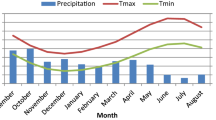Abstract
A relatively new method of addressing different hydrological problems is the use of artificial neural networks (ANN). In groundwater management ANNs are usually used to predict the hydraulic head at a well location. ANNs can prove to be very useful because, unlike numerical groundwater models, they are very easy to implement in karstic regions without the need of explicit knowledge of the exact flow conduit geometry and they avoid the creation of extremely complex models in the rare cases when all the necessary information is available. With hydrological parameters like rainfall and temperature, as well as with hydrogeological parameters like pumping rates from nearby wells as input, the ANN applies a black box approach and yields the simulated hydraulic head. During the calibration process the network is trained using a set of available field data and its performance is evaluated with a different set. Available measured data from Edward’s aquifer in Texas, USA are used in this work to train and evaluate the proposed ANN. The Edwards Aquifer is a unique groundwater system and one of the most prolific artesian aquifers in the world. The present work focuses on simulation of hydraulic head change at an observation well in the area. The adopted ANN is a classic fully connected multilayer perceptron, with two hidden layers. All input parameters are directly or indirectly connected to the aquatic equilibrium and the ANN is treated as a sophisticated analogue to empirical models of the past. A correlation analysis of the measured data is used to determine the time lag between the current day and the day used for input of the measured rainfall levels. After the calibration process the testing data were used in order to check the ability of the ANN to interpolate or extrapolate in other regions, not used in the training procedure. The results show that there is a need for exact knowledge of pumping from each well in karstic aquifers as it is difficult to simulate the sudden drops and rises, which in this case can be more than 6 ft (approx. 2 m). That aside, the ANN is still a useful way to simulate karstic aquifers that are difficult to be simulated by numerical groundwater models.
Similar content being viewed by others
References
Bhattacharjya RK, Datta B (2005) Optimal management of coastal aquifers using linked simulation optimization approach. Water Resour Manage 19:295–320
Boegli A (1980) Karst hydrology and physical speleology. Springer-Verlag, Berlin
Chester DL (1990) Why two hidden layers are better than one. In: Proceedings of the international joint conference on neural networks, vol I. Theory Track Neural and Cognitive Sciences Track, Washington, pp 265–268
Coppola EA, Rana AJ, Poulton MM, Szidarovszky F, Uhl VW (2005) A neural network model for predicting aquifer water level elevations. Ground Water 43:231–241
Coulibaly P, Anctil F, Bobee B (2000) Daily reservoir inflow forecasting using artificial neural networks with stopped training approach. J Hydrol 230:244–257
Feng S, Kang S, Huo Z, Chen S, Mao X (2008) Neural networks to simulate regional ground water levels affected by human activities. Ground Water 46:80–90
Garcia LA, Shigidi A (2006) Using neural networks for parameter estimation in ground water. J Hydrol 318:215–231
Haykin S (1999) Neural networks: a comprehensive foundation. Prentice Hall, New Jersey
Kroese B, van der Smagt P (1996) An introduction to neural networks. University of Amsterdam, Amsterdam
Lallahem S, Mania J (2003) A nonlinear rainfall-runoff model using neural network technique: example in fractured porous media. Math Comput Model 37:1047–1061
Lallahem S, Mania J, Hani A, Najjar Y (2005) On the use of neural networks to evaluate groundwater levels in fractured media. J Hydrol 307:92–111
Maier HR, Dandy GC (2000) Neural networks for the prediction and forecasting of water resources variables: a review of modelling issues and applications. Environ Model Softw 15:101–124
Mohanty S, Jha MK, Kumar A, Sudheer KP (2009) Artificial neural network modeling for groundwater level forecasting in a river island of Eastern India. Water Resour Manage. Online first doi:10.1007/s11269-009-9527-x
Nayak P, Rao Y, Sudheer K (2006) Groundwater level forecasting in a shallow aquifer using artificial neural network approach. Water Resour Manage 20:77–90
Nikolos IK, Stergiadi M, Papadopoulou MP, Karatzas GP (2008) Artificial neural networks as an alternative approach to groundwater numerical modelling and environmental design. Hydrol Process 22:3337–3348
Safavi HR, Darzi F, Mariño MA (2009) Simulation–optimization modeling of conjunctive use of surface water and groundwater. Water Resour Manage. Online first doi:10.1007/s11269-009-9533-z
Scanlon BR, Mace RE, Barrett ME, Smith B (2003) Can we simulate regional groundwater flow in a karst system using equivalent porous media models? Case study, Barton Springs Edwards aquifer, USA. J Hydrol 276:137–158
Schindel GM, Hamilton JM, Johnson S, Mireles J, Esquilin R, Burgoon C, Luevano G, Gregory D, Gloyd R, Sterzenback J, Mendoza R (2007) Hydrologic data report. Edwards Aquifer Authority. http://www.edwardsaquifer.org. Accessed August 2008
Trichakis IC, Nikolos IK, Karatzas GP (2009) Optimal selection of artificial neural network parameters for the prediction of a karstic aquifer’s response. Hydrol Process 23:2956–2969
Author information
Authors and Affiliations
Corresponding author
Rights and permissions
About this article
Cite this article
Trichakis, I.C., Nikolos, I.K. & Karatzas, G.P. Artificial Neural Network (ANN) Based Modeling for Karstic Groundwater Level Simulation. Water Resour Manage 25, 1143–1152 (2011). https://doi.org/10.1007/s11269-010-9628-6
Received:
Accepted:
Published:
Issue Date:
DOI: https://doi.org/10.1007/s11269-010-9628-6




